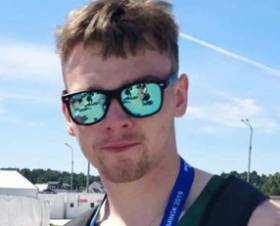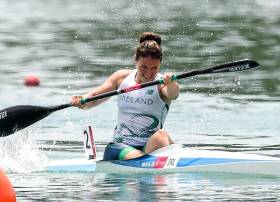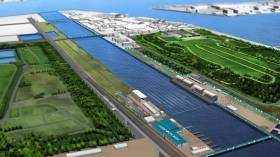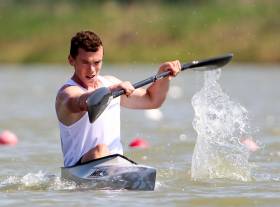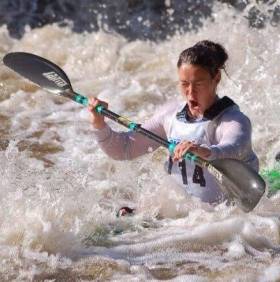Displaying items by tag: Canoe Sprint
In Canoe Sprint, Ireland's Jenny Egan-Simmons got her season off to a neat perfect start winning bronze at the second World Cup race of 2022.
This podium finish takes Egan-Simmons into the double digits of international medals, with her 10th medal in the bag.
The second round of the 2022 Canoe Sprint World Cup was marred with extremely high winds, resulting in racing being postponed for the best part of most of the competition days, testing the adaptability and mental toughness of all competing.
Competing against these conditions and their rivals for Ireland were Paralympian Patrick O’Leary and Jenny Egan-Simmons. Patrick was lining up in the VL3 and KL3, with Jenny racing in her favoured 5000m. In what was his first outing onto the start-line after the Tokyo 2020 Paralympic Games Patrick displayed promising pace, qualifying through to the final of the KL3 200m, finishing in 9th overall. The VL3 proved more challenging, where Patrick finished 7th in his heat, missing the cut for the semi-final.
The final day of racing saw a significant improvement in both the conditions and the fortunes of the Irish Team. With a 4th place finish already under her belt from the previous week's World Cup race, Egan-Simmons had plenty of momentum going into the final of the women’s 5000m. This showed with a confident display of racing from Egan-Simmons, pushing right until the line in a close fight for the silver medal. The tight battle went just the other way with Melina Andersson (SWE) taking silver and Jenny taking the bronze. This medal also marked a milestone in Jenny’s career, her 10th international medal for Ireland.
C Final Place for Jenny Egan at World Championships
#Canoeing: Jenny Egan took eighth in her semi-final of the K1 500 metres and moved into the C Final at the canoe sprint World Championships in Szeged in Hungary today. The top three qualified for the A Final and stayed in contention for qualifying places for the Olympic Games.
Barry Watkins finished ninth in the B Final of the men’s K1 1,000 metres, 18th overall, while Egan had taken sixth in the C Final of the K1 200m, 24th overall.
Canoe Sprint World Championships, Szeged, Hungary
Men
K1 1,000m – B Final: 9 B Watkins 3:47.24
Women
K1 200m C Final: 6 J Egan 6:43.49
K1 500m Semi-Final Three (First Three to A Final; 4-6 to B Final; 7-9 to C Final): 8 Egan 2:00.01.
Ronan Foley Sixth in World Under-23 Final
#Canoeing: Ronan Foley finished sixth in the A Final of the men’s K1 1,000 metres at the canoe sprint World Under-23 Championships today in Pitesti, Romania. Thomas Green of Australia won gold, with Germany’s Jakob Thordsen second and Hungary’s Adam Varga third. Foley, in his first year since moving up from junior, came in 8.24 seconds behind Green.
Watkins and Egan Qualify for World Cup Semi-Finals
#Canoeing: Jenny Egan and Barry Watkins qualified for semi-finals at the canoe sprint World Cup in Poznan, Poland. Egan finished fifth in her heat of the K1 200m, while Watkins matched this in the men’s K1 1,000. The paracanoeist Patrick O’Leary reached the final of the VL3 by taking third in his semi-final.
Canoe Sprint World Cup, Poznan, Poland (Irish interest)
Men
K1 1000 – Heat Two: 8 Ronan Foley. Heat Five: 5 Barry Watkins
K1 200m – Heat Two: 5 Ryan O’Connor
Women
K1 200m – Heat Six: 5 Jenny Egan
Paracanoeing: VL3 Men’s 200m – Semi-Final One: 3 Patrick O’Leary. KL3 Semi-Final: 4 O’Leary
O'Leary Ninth in A Final as Egan Misses Out
#Canoeing: Patrick O’Leary finished ninth in the A Final of the KL3 200 metres at the Paracanoe World Championships in Racice in the Czech Republic. The race was won by Serhii Yemelianov of the Ukraine.
Jenny Egan finished eighth in her semi-final of the K1 200 at the Canoe Sprint World Championships, also at Racice. She missed out on an A or B Final place. Egan is set to compete in the K1 5,000 metres on Sunday.
Jenny Egan Takes Bronze at World Cup in Serbia
#Canoeing: Ireland’s Jenny Egan took a bronze medal at the canoe sprint World Cup in Belgrade in Serbia today. Australia’s Alyssa Bull took the gold in the K1 5,000 metres from Laia Pelachs of Spain.
Egan (30) started her season with a win in the K1 5,000 at the first World Cup in Montemor-O-Velho in Portugal. She also competed in the second World Cup in Szeged in Hungary.
Canoe Sprint World Cup, Belgrade (Selected Results; Irish interest)
Women
K1 5,000 – Final: 1 Australia (A Bull) 22 minutes 26.080 seconds, 2 Spain (L Pelachs) 22:27.83, 3 Ireland (J Egan) 22:35.60.
Rowing & Canoeing Look Set To Stay In Tokyo For 2020 Games
#Tokyo2020 - Irish Olympic rowing and canoeing hopefuls look set to stay in Japan’s capital for the 2020 Games as plans to move their venue to a city 400km north are likely to be abandoned.
As Inside the Games reports, Tokyo 2020 organisers are expected to downscale their costly original plans for the Sea Forest in Tokyo Bay instead of moving to the city of Tome in Miyagi Prefecture.
Rowing and canoe sprint were among a number of sports that faced the prospect of their venues being relocated Tokyo to surrounding cities as city officials look to trim rising costs even three-and-a-half years out from the Games.
Inside the Games has more on the story HERE.
Egan Seventh in Second Olympic Qualifier Final
#Canoeing: Jenny Egan finished seventh in her K1 200m final at the canoe sprint European Olympic Qualifier in Duisburg in Germany today. Germany and Sweden secured the top two spots, and with them places at the Olympic Games in Rio de Janeiro. Egan was in the middle of the group from third to ninth who were covered by less than a second. The Irishwoman was competing in her second final of the day.
Tom Brennan finished ninth in his final of the K1 200, with the top two of Spain and Hungary qualifying for Rio de Janeiro.
Canoe Sprint European Olympic Qualifier, Duisburg, Germany (Selected Results, Irish interest)
Men
K1 1,000 – Final: 1 Hungary (B Dombvári) 3 min 35.307, 2 Russia (R Anoshkin) 3:35.695; 4 M Fitzsimon 3:38.727.
K1 200 – Final: 1 Spain (S Craviotto) 34.615, 2 Hungary (Be Horváth) 35.077; 9 T Brennan 36.773.
Women
K1 500 – Final: 1 Germany (S Hering) 1 min 55.378, 2 Slovakia (M Kohlová) 1:55.677; 8 J Egan 2:00.270.
K1 200 – Final: 1 Germany (S Volz) 41.470, 2 Sweden (L Stensils) 41.509; 7 J Egan 42.874.
Paracanoe World Championships, Duisburg
Men - KL3 200 – B Final (Places 10-18): 1 P O’Leary 42.882 seconds.
Fitzsimon Fourth in Final of Olympic Qualifier
#Canoeing: Michael Fitzsimon finished fourth in the final of the K1 1,000 at the canoe sprint European Olympic Qualifier in Duisburg in Germany this morning. The perfomance was another step up for the man who has been competing as an under-23 paddler, but it was outside the places which would have qualified him for the Olympic Games.
Canoe Sprint European Olympic Qualifier, Duisburg, Germany (Selected Results, Irish interest)
Men
K1 1,000 – Final: 1 Hungary (B Dombvári) 3 min 35.307, 2 Russia (R Anoshkin) 3:35.695; 4 M Fitzsimon 3:38.727.
Women
K1 500 – Final: 1 Germany (S Hering) 1 min 55.378, 2 Slovakia (M Kohlová) 1:55.677; 8 J Egan 2:00.270.
Ireland Reach Four Finals at Olympic Qualifier
#Canoeing: Ireland brought their tally of finals reached to four at the canoe sprint European Olympic Qualifier in Duisburg today. Jenny Egan made her way to a second final – the K1 200 – and Tom Brennan for the men’s equivalent in the afternoon session. They will qualify for Rio if they finish in the top two in their finals.
Canoe Sprint European Olympic Qualifier, Duisburg, Germany (Selected Results, Irish interest)
Men
K1 1,000 – Heat One (Winner to A Final; 2-7 to semi-final; rest out): 4 M Fitzsimon 3:31.693. Semi-Final: 1 Fitzsimon 3:31.453.
K1 200 – Heat Two (Winner to Final; 2-7 to semi-final; rest out): 4 T Brennan 35.85. Semi-Final (Three to Final; rest out): 3 Brennan 35.938.
K2 200 – Heat One (First Three to A Final; 4-7 to semi-final): 6 T Brennan, B Watkins 34.350. Semi-Final (First Three to A Final; rest out): 5 Brennan, Watkins 34.249.
Women
K1 500 – Heat One (Three to Final; 4-7 to Semi-Final): 5 J Egan 1:55.428. Semi-Final (Three to A Final): 3 Egan 1:52.823.
K1 200 – Heat One (Three to Final; 4-7 to Semi-Final): 3 J Egan 41.515.
Paracanoe World Championships, Duisburg
Men - KL3 200- Heat Four (First Seven to Semi-Final): 2 P O’Leary 42.061. Semi-Final One (First Two and next best time to A Final; 3rd, 4th to B Final): 3 O’Leary 41.722.



























